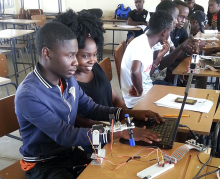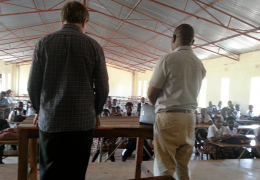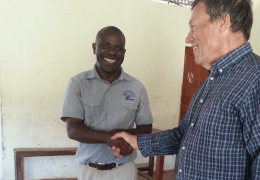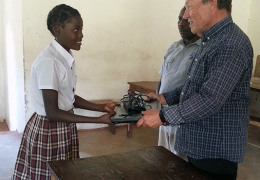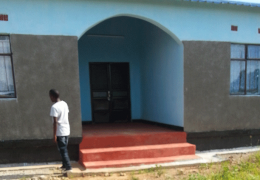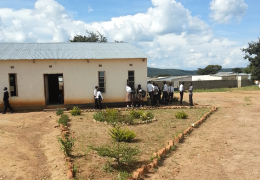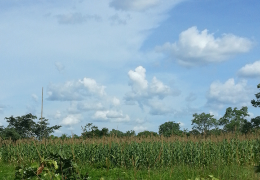The objective of the CiTA project is to give pupils and student an opportunity to get in touch with technique and engineering. And when we say engineering these days we mean electrical and mechanical devices controlled by (simple) computers. These devices can vary from all kind of sensors to simple mechanical devices like moving robot arms. That sounds like a substantial investment but prices in this area have dropped tremendously during the last few years: since computers are usually already available in Secondary Schools, a complete laboratory set for two students can be made available for between 50 and 100 euro (between 60 and 120 dollar). And most of the students are really eager to experiment with this equipment. However, some guidance and support will always be needed at this level, even for the most motivated students and even when detailed handouts are available. And this is just the problem in many Secondary Schools. Staff is often not familiar with the topic and, if they are, there is a good chance they leave to industry. That is to a large extend why the recent introduction at two schools did not have the success that was hoped for.
As from this year we will follow a different approach: at three universities a regular practicum focusing on the CiTA subject area is introduced or extended. These universities are University of Nairobi (UoN), the University of Zambia (UNZA) and the Kapassa Makassa University (KMU; a new university in the north of Zambia). The universities have offered to let their facilities and knowledge have a spin-off towards Secondary Education. They will train teachers and advise them with the introduction of these new topics in their teaching. At the KMU this happens very directly: the practicum is being introduced in the program 'ICT and Education' that focuses on ICT teachers in secondary schools. In all cases the approach is such that SOZ supplies equipment and develops manuals and handouts and the respective universities take care of staffing and organization.
In preparation of the introduction of CiTA a number of workshops have been given. The picture shows the workshop at KMU: especially the programming of a simple robot arm is an experiment that is carried out with a lot of enthusiasm.
The equipment has been left with the universities. This year and early next year the remainder of the practicum will be implemented. For those interested, the handout of the workshop can be downloaded from the page 'Documents'.
W&O Europe BV has donated a number of used laptops. These computers were handed over to the ICT department of Kalwala Secondary School. One of the laptops, however, was given as an incentive prize to a promising student in the area of ICT. The picture shows the handing over of the prize. A promise was made to the school to try and obtain more donations in this area. In that way we could make the award into a yearly tradition.
The Secondary School in Kalwala is doing well. In the last exams they were third in the province. Recently the boys dormitory has been completed - the girls dormitory is already in use for over a year. The availability of the dormitories is an enormous improvement for those students that live too far from the school to walk home every day. The school looks clean and neat. The school garden gives a sufficient harvest to supply all students with a healthy lunch every day.
The objective of the CiTA project is to give pupils and student an opportunity to get in touch with technique and engineering. And when we say engineering these days we mean electrical and mechanical devices controlled by (simple) computers. These devices can vary from all kind of sensors to simple mechanical devices like moving robot arms. That sounds like a substantial investment but prices in this area have dropped tremendously during the last few years: since computers are usually already available in Secondary Schools, a complete laboratory set for two students can be made available for between 50 and 100 euro (between 60 and 120 dollar). And most of the students are really eager to experiment with this equipment. However, some guidance and support will always be needed at this level, even for the most motivated students and even when detailed handouts are available. And this is just the problem in many Secondary Schools. Staff is often not familiar with the topic and, if they are, there is a good chance they leave to industry. That is to a large extend why the recent introduction at two schools did not have the success that was hoped for.
As from this year we will follow a different approach: at three universities a regular practicum focusing on the CiTA subject area is introduced or extended. These universities are University of Nairobi (UoN), the University of Zambia (UNZA) and the Kapassa Makassa University (KMU; a new university in the north of Zambia). The universities have offered to let their facilities and knowledge have a spin-off towards Secondary Education. They will train teachers and advise them with the introduction of these new topics in their teaching. At the KMU this happens very directly: the practicum is being introduced in the program 'ICT and Education' that focuses on ICT teachers in secondary schools. In all cases the approach is such that SOZ supplies equipment and develops manuals and handouts and the respective universities take care of staffing and organization.
In preparation of the introduction of CiTA a number of workshops have been given. The picture shows the workshop at KMU: especially the programming of a simple robot arm is an experiment that is carried out with a lot of enthusiasm.
The equipment has been left with the universities. This year and early next year the remainder of the practicum will be implemented. For those interested, the handout of the workshop can be downloaded from the page 'Documents'.
W&O Europe BV has donated a number of used laptops. These computers were handed over to the ICT department of Kalwala Secondary School. One of the laptops, however, was given as an incentive prize to a promising student in the area of ICT. The picture shows the handing over of the prize. A promise was made to the school to try and obtain more donations in this area. In that way we could make the award into a yearly tradition.
The Secondary School in Kalwala is doing well. In the last exams they were third in the province. Recently the boys dormitory has been completed - the girls dormitory is already in use for over a year. The availability of the dormitories is an enormous improvement for those students that live too far from the school to walk home every day. The school looks clean and neat. The school garden gives a sufficient harvest to supply all students with a healthy lunch every day.


